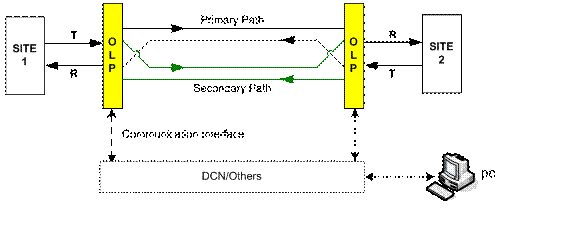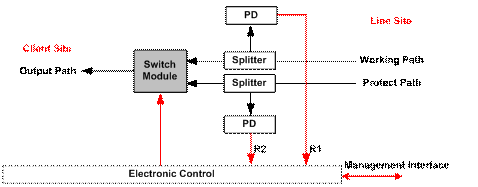Know more about OLP Optical Line Protection
overview
optical line protection system (olp) uses vacant optical fiber from different route to build a backup path. by real-time monitoring the power status in working fiber, it can automatically switch from working fiber to backup fiber when the power value of working fiber lower than a user defined threshold. olp will provide you a more reliable, flexible and high secure optical transmission network .it is widely used for protecting backbone and important business line.
olp shown as the figure below
features
1.Reduce interrupt time of communication and improve maintenance efficiency with quickly recovering communication
2.Remarkably reduce damage to network caused by fiber failure
3.Increase network reliability and improve service quality
4.Harmless switch between working path and secondary path and convenient for line overhaul and cutover
5.Real-time monitoring power level of fiber
6.Support remote control, easy management and maintenance
7.Transparent transmission
1. Where OLP use?
1+1 Optical Line Protection System for Fibre Protection.
It is widely used in Optical Line Protection System like PDH, SDH system, C/DWDM system, electric telecommunication exclusive net as well as CATV optical net.
OLP(Optical Line Protection) is a device used in pairs, one at each end of the optical signal to protect network transmission line. It can realize optical power monitoring and automatic switching.
How OLP works?
In optical communication network, OLP monitors optical power of optical fibre and standby optical fibre at real time. In case the current optical power of optical fibre is less than pre-set switching threshold value, then alarm is on and it would switch to standby optical fibre automatically to protect optical transmission system line.
How is HTF OLP equipmnet?
Optical line protection (OLP) system is a new optical line protection subsystem developed with advanced technology of dynamic and synchronous optical switches. When communication quality is lower or equipment breaks down due to accidental fracture or bigger loss of optical fiber in the optical transmission line, the OLP system can switch the primary line to the secondary line within a short time, to ensure normal operation communication of line, which effectively prevent fiber or equipment fault and shorten the recovery time from hours to milliseconds.
olp system
2.1working theory
OLP 1+1 adopts the mode of dual transmitting and selective receiving.
OLP 1:1
OLP configuration 1:1, as shown in the diagram below, consisting of the main fiber route and a standby fiber route between the two sites and associated fiber optical switches. In normal operation, the data are transmitted and received through the main route. Inside the OLP pair, detectors are incorporated at Rx ports to detect the decreasing of the optical power. When a fault is detected on the main route, the system will switch both the transmitting and receiving from the main route to the standby route. This is accomplished by first turn off the build-in test laser so that both ends detect fault. The advantages of 1:1 OLP system are low optical insertion loss with direct signal passthrough, and the optical fiber for the backup path can also be used for other business. The disadvantage is conventional systems require CPU processing the information at both ends, resulting in typically delays of about 80ms in response.

OLP 1+1
OLP 1+1 configuration is shown in the following diagram, in which the optical signals are split into two with a ratio of 50:50 and transmit through both main and standby routes at the same time. While for Rx, the optical signal with better quality will be selected when a fault is detected. The advantage of OLP 1+1 system is faster recovering optical switching. We offer 100ns recovering option in this configuration. However, there will be larger insertion loss compared with the OLP 1:1 system.

OLP 1-1

2.2 specifications
| 1:1 | 1+1 | 1-1 | |
| work working wavelength/nm | 131050nm and 155050nm | ||
| monitoring power range/dbm | 23-50 | ||
| monitoring power accuracy /db | 0.25 | ||
| monitoring power resolution/db | 0.01 | ||
| return loss/db | 55 | ||
| pdl/db | 0.05 | ||
| wdl/ db | 0.1 | ||
| insertion loss/db | tx<1.2rx<1.2 | tx<4rx<1.2 | <1.2 |
| switching time/ ms | <35 | <15 | <15 |
| durability(life)/times | >107 | ||
| operating temperature | -10+60c | ||
| storage temperature | -20+75c | ||
| power supply/ | dc(36-72)v and ac(85-264)v/50~60hzdual power supply | ||
| power-down condition | hold in working path or switch to backup path | ||
| optical connectors | sc/pc | ||
| size | standard 19' 1u/4u | ||
2.3 ordering information
| ordering type | ||||
| 1u | gj-olp-1u-1:1 | gj-olp-1u-1+1 | gj-olp-1u-1-1 | |
| 4u | chassis | gj-olp-4u | ||
| module | gj-olp-m-1:1 | gj-olp-m-1+1 | gj-olp-m-1-1 | |
| 4u olp system with the chassis (including power module and manage module) and pluggable module. | ||||
2.4 application example

OLP-Optical Line Protection is a device that is used in the protection of network transmission line, it can realize optical power monitoring and automatic switching. In optical communication network, OLP constantly monitors optical power of working optical fiber and standby optical fiber. When the optical power value of working optical fiber is below the set switching threshold, the system raise the alarm prompt and switches to standby fiber automatically, which achieve line protection of optical transmission system.
Heyoptics provides 3 types of line protection: 1:1 line protection, 1+1 line protection and 1-1 line protection . Wavelengths and connectors can be customized to meet special control and applications.



